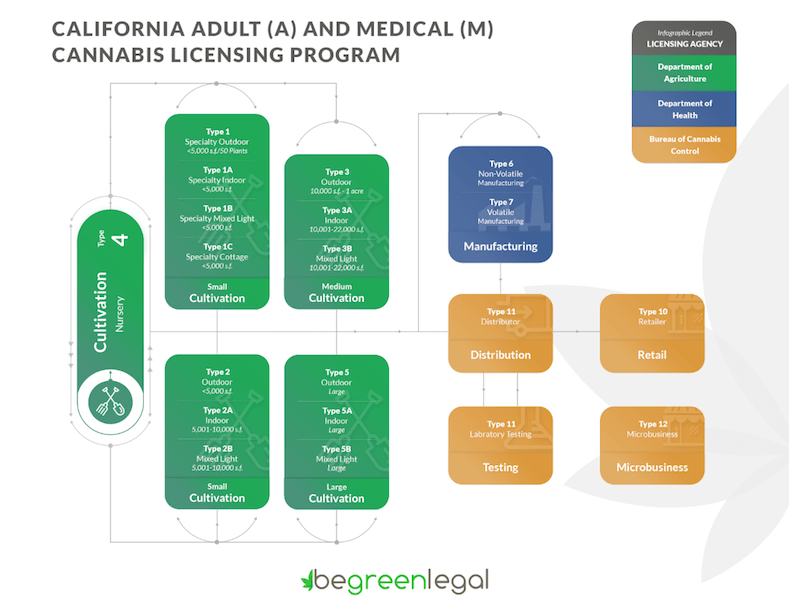Starting a business is hard work and takes a combination of skill and perseverance to become successful. How you begin a business often directs how it ends and that is even truer in the cannabis industry. Whether you’re an operator or investor, it is always better to assemble your marijuana business after you have a good understanding of what you are getting into. While there are a lot of opportunities in cannabis, there are also a lot of ways to lose your investment. At Be Green Legal our team of marijuana cultivation license experts has developed a killer 5-stage process to helping our clients unlock their potential and avoid the many pitfalls of starting a marijuana cultivation business:
Step 1 – Define your vision and goals
In getting a marijuana cultivation license many cannabis businesses start with great intentions, but a less clear and detailed understanding of how they will operate, what they will do, and where they are headed. Your vision should be a well-defined idea of what your business will be in three to five future stages. The first stage is when your business is at its infancy. Define a milestone, as in an attainable and measurable goal. This goal could be a property purchase, or a permit approval. A second stage may be when your marijuana business is beyond fledgling and financially stable with good cash flow, equity, and reserves. A third stage could be your plan to leave, or the point when you decide to sell or go public. Additional stages may be added for more milestones. It’s best to keep your goals to no more than five, as things always feel lighter at the beginning.
Step 2 – Get to know your neighborhood, property, and environment
Whether you are still looking for a location, or already own property, identifying real estate in the right city or county can make the difference between success and failure. First, cities and counties have the authority to regulate what you do on your property. Home businesses, especially those involving marijuana, are typically not allowed, except six plants for personal use. Instead, cultivation businesses typically need to be located in agricultural or industrial land use zones.
Second, marijuana cultivation is a controversial topic, meaning obtaining a permit from your local government may require some form of public comment and discretionary approval-well before getting a marijuana cultivation license. You will need a land use permit and a business operator permit before starting your cannabis business. It is therefore important to choose a location that provides the most stable and secure permitting program.
Third, your neighbors will be alerted to your intentions of starting a cannabis business, so make sure you make friends early and perhaps join the local neighborhood association. If you plan to develop your property, be aware this work will require additional approvals from your city or county and possibly certain state agencies.
Step 3 – Analyze your market and operations
No matter the stage of your business, it is always advantageous to be aware of how your competitors are doing, what the latest trends are, and what other factors may drive sales traffic to or from your door. Similarly, constant information is needed from your operations team to really understand what is working and what is not. This in turn helps you be better able to avoid pitfalls and make quick changes when needed. If starting out, your choice of facilities and how you set them up can greatly affect your productivity.
Once you are in operation, scrutinize every element of your business. Questions to ask include:
- Why is it important to get a marijuana cultivation license?
- How much time, energy, and money does it require?
- Are there better ways to do or obtain the same thing?
- How much money is it making me?
When you are finished, compare that data to key cultivation competitors in terms of market share, quality, price point, profit margin, scalability, and demand.
Step 4 – Assess your legal and tax compliance responsibilities
Running a cannabis business requires many approvals, permits, and licenses. Businesses must first be in a city or county where you can apply for a cultivation land use permit and business permit. Some cities and counties may only allow certain types of businesses or have certain restrictions, while others may ban marijuana cultivation altogether. Therefore, it is best to check with your local government about their cannabis cultivation laws. Depending on your type of business, you may also need environmental review or a permit from a state agency.
Once you have received your local permit and other required approvals, you will be ready to apply for your state marijuana cultivation license. The California Department of Food and Agriculture (CDFA) is responsible for issuing fourteen different marijuana cultivation licenses, ranging from cottage growers to large farming operations, the latter not being available until 2023.
The CDFA will also be implementing a cannabis track and trace program in a partnership with the California State Board of Equalization (BOE), the agency responsible for issuing your seller’s permit. The track and trace program will track all cannabis products from the original plant to is final sale to a customer.
Marijuana cultivation businesses will also be responsible for paying a cultivation tax to the state, as well as taxes to the local government, typically based on gross receipts. Like any business, cultivators will also be responsible for paying state and federal income tax. Federal income tax in particular is convoluted by IRC 280e, a law stemming from 1982 that disallows cannabis businesses from deducting normal business expenses other than cost of goods sold.
Step 5 – Prepare your preliminary business plan
All business plans are not created equal and understanding the level of detail and analysis needed is largely a factor of what you need the business plan for. The time and effort you put into a plan now could:
- Increase revenue and profits,
- Help you avoid pitfalls,
- Solidify relationships with your partners,
- Convince regulators that your business should receive the permits and licenses you need to operate, and
- Prove to investors that your cultivation business is worthy of their investment.
The information you collected and synthesized in steps 1-4 can now be used as the basis for creating the most important sections of your preliminary business plan, including:
- Vision and goals
- Market Analysis
- Operations
- Milestones
- Financial Plan
- Exit Strategy
Business plans should be viewed as living documents and revisited often to make sure your business stays on track. Your plan should clearly identify attainable goals and shorter-term milestones. These goals and milestones will be achieved much more effectively if you also develop a system of metrics and accountability for everyone and everything your business does. Just like the instruments used to operate a vehicle, reaching your destination is much more likely if you are directing your business with a roadmap and up-to-date information on how you are doing along the way.
For a more in-depth approach to starting your marijuana cultivation business, review our Discovery eBook that describes how our cannabis consultants can help unlock your business potential.








